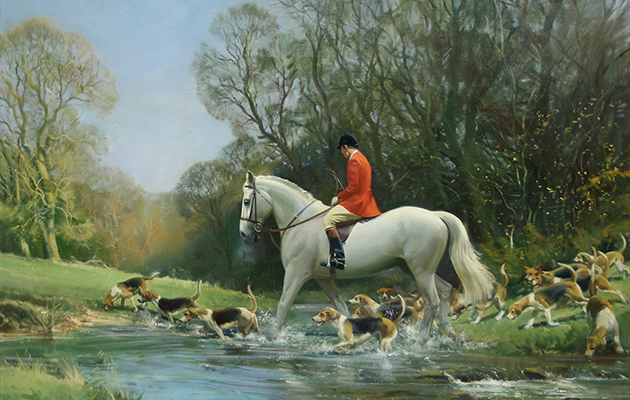It may be considered the bottom of the hierarchy of genres, but equestrian art belongs to the people like no other, says Janet Menzies
The great equestrian artists have aimed to capture the colour, glamour and excitement of their world since the very beginning. It may be considered bottom of the hierarchy, but equestrian art belongs to the people, says Janet Menzies.
For more sporting artists, James Wild tells the stories of animals in the world today using sculpture and scrap metal. And Tod Ramos developed his equestrian art alongside a career in race riding.
THE GREAT EQUESTRIAN ARTISTS
Equestrian art’s canvas version of the Dublin Horse Show has galloped into Chelsea and is now bucking and kicking in an exhibition at The Open Art Fair. It is a joyful explosion of ‘horseyness’. There are thoroughbreds, of course, nostrils flared and coats gleaming. And, just like the Dublin Show, there are posh hunters and show hacks, who are just as much status symbols as the racehorses.

The Holloa by Hardy.
There is colour, there is glamour, and excitement, and nerves — and there are people. Is equestrian art about the horses or the people? Wherever horses take you, there are people to tell a story. If it’s the Derby at Epsom, there’s Prince Monolulu shouting: “I got a horse!” Or today’s version of Munnings’ gypsy rider will be pulling a colt out of the stall for you at the sales, with a confiding whisper: “The sheikh’s been to see this one.”
Equestrian artists seek to capture all this rambunctious life and have done since the beginning. Jamie Rountree, of the Rountree Tryon Gallery, is showing at the exhibition. He believes one of the most important aspects of equestrian art is its connectedness: “Sporting art should be seen as an intriguing historical document of a nation’s rise and fall, especially its love affair with the horse.” Rountree points out: “In the days when horses were important facets of everyday life the ‘Sporting’ artist was developed. Painters, who loved their subject, were highly skilled and concentrated on showcasing their patron’s status, especially concerning the horse.”

Portrait of a gentleman on a bay horse with a church beyond by Munnings.
Rountree highlights the two founders of sporting art in the early part of the 18th century, James Seymour and John Wootton. He reveals: “Seymour was addicted to horse racing and the nefarious art of gambling, while Wootton was socially adept and finessed his way around the aristocratic world of Georgian England.” The inevitable influence of wealthy patrons, along with favourable public reaction to equestrian art, makes it a social barometer, both then and now. The populism of equestrian art was always part of the genre. Archie Parker, of the Parker Gallery, is exhibiting John Frederick Herring Snr.
UNIVERSAL APPEAL
Parker points out: “In 1825, the Doncaster Gazette arranged for him to paint the winners of the St Leger from 1815 onwards. The pictures were then engraved and initially published by Messrs Sheardown & Son, owners of the Doncaster Gazette.” You can just imagine a tabloid producing a similar offer today, and much equestrian art has an element of slightly seamy charisma that gives its world a universal appeal.
Parker is also exhibiting the late-18th- and early-19th-century artist, Francis Sartorius. Parker notes: “Inevitably, given that his patrons were mainly country gentleman, he was itinerant, and seems to have painted in many of the counties of England, as well as being one of the first purely sporting painters to work in Ireland. Sartorius kept his studio in Soho, at Spur Street just off Leicester Square, producing a huge number of sporting and equestrian works. He has left us with an invaluable record of all the country sports during their golden age.”

John Beard, groom to Captain Bertie holding Sportsman aged 10, his bay hunter, and Sancho, his favourite dog by Sartorius.
For Rountree, two artists in particular were emblematic of their eras: “Stubbs pushed the genre beyond just the aristocratic pursuits of a few into the mainstream consciousness of a nation. The British public fell in love with not just sporting art, but also the beautiful animals that he painted so brilliantly. The British adoration for horses has not dimmed over the 250 years since Stubbs was in his prime.” But the horse’s place at the centre of everyday life did diminish, and Rountree points out: “Munnings, the last of the great British sporting painters, documented the change with an emotional longing of a man who loved his subject matter. The subjects that he chose, such as A Gypsy Encampment, were evocative of a time when human and horse worked so closely together that they became a family unit — halcyon, carefree days.”
Munnings is far from the last of our sporting artists, and the contemporary genre is as popular as ever. Tom Rooth, of Tom Rooth Fine Art, is taking the opportunity to show a solo selection of the work of Belgian-born equestrian artist Elie Lambert. Racing commentator Sir Peter O’Sullevan was an admirer and loved 71-year-old Lambert’s ‘racehorses wearing Louboutin heels’. Lambert’s life has been wonderfully wide-ranging, including not just horse racing and training but also the Navy and journalism, all over the world from Washington DC to Newmarket and now Deauville.
Sporting and equestrian themes have always been considered to be the bottom of the hierarchy of genres headed by history and portraiture. Yet this direct, figurative art, and its sometimes rackety artists, belongs to the people like no other.





